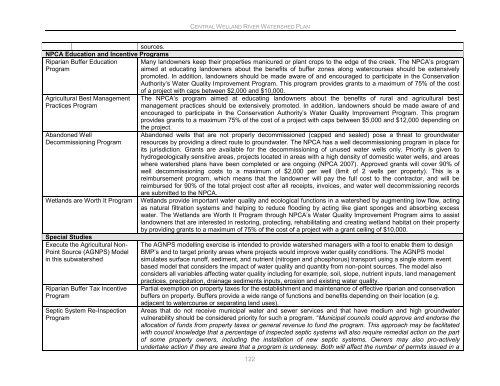Central Welland River Watershed Plan - Niagara Peninsula ...
Central Welland River Watershed Plan - Niagara Peninsula ...
Central Welland River Watershed Plan - Niagara Peninsula ...
- No tags were found...
You also want an ePaper? Increase the reach of your titles
YUMPU automatically turns print PDFs into web optimized ePapers that Google loves.
CENTRAL WELLAND RIVER WATERSHED PLANsources.NPCA Education and Incentive ProgramsRiparian Buffer Education Many landowners keep their properties manicured or plant crops to the edge of the creek. The NPCA‟s programProgramaimed at educating landowners about the benefits of buffer zones along watercourses should be extensivelypromoted. In addition, landowners should be made aware of and encouraged to participate in the ConservationAuthority‟s Water Quality Improvement Program. This program provides grants to a maximum of 75% of the costAgricultural Best ManagementPractices ProgramAbandoned WellDecommissioning ProgramWetlands are Worth It ProgramSpecial StudiesExecute the Agricultural Non-Point Source (AGNPS) Modelin this subwatershedRiparian Buffer Tax IncentiveProgramSeptic System Re-InspectionProgramof a project with caps between $2,000 and $10,000.The NPCA‟s program aimed at educating landowners about the benefits of rural and agricultural bestmanagement practices should be extensively promoted. In addition, landowners should be made aware of andencouraged to participate in the Conservation Authority‟s Water Quality Improvement Program. This programprovides grants to a maximum 75% of the cost of a project with caps between $5,000 and $12,000 depending onthe project.Abandoned wells that are not properly decommissioned (capped and sealed) pose a threat to groundwaterresources by providing a direct route to groundwater. The NPCA has a well decommissioning program in place forits jurisdiction. Grants are available for the decommissioning of unused water wells only. Priority is given tohydrogeologically sensitive areas, projects located in areas with a high density of domestic water wells, and areaswhere watershed plans have been completed or are ongoing (NPCA 2007). Approved grants will cover 90% ofwell decommissioning costs to a maximum of $2,000 per well (limit of 2 wells per property). This is areimbursement program, which means that the landowner will pay the full cost to the contractor, and will bereimbursed for 90% of the total project cost after all receipts, invoices, and water well decommissioning recordsare submitted to the NPCA.Wetlands provide important water quality and ecological functions in a watershed by augmenting low flow, actingas natural filtration systems and helping to reduce flooding by acting like giant sponges and absorbing excesswater. The Wetlands are Worth It Program through NPCA‟s Water Quality Improvement Program aims to assistlandowners that are interested in restoring, protecting, rehabilitating and creating wetland habitat on their propertyby providing grants to a maximum of 75% of the cost of a project with a grant ceiling of $10,000.The AGNPS modelling exercise is intended to provide watershed managers with a tool to enable them to designBMP‟s and to target priority areas where projects would improve water quality conditions. The AGNPS modelsimulates surface runoff, sediment, and nutrient (nitrogen and phosphorus) transport using a single storm eventbased model that considers the impact of water quality and quantity from non-point sources. The model alsoconsiders all variables affecting water quality including for example, soil, slope, nutrient inputs, land managementpractices, precipitation, drainage sediments inputs, erosion and existing water quality.Partial exemption on property taxes for the establishment and maintenance of effective riparian and conservationbuffers on property. Buffers provide a wide range of functions and benefits depending on their location (e.g.adjacent to watercourse or separating land uses).Areas that do not receive municipal water and sewer services and that have medium and high groundwatervulnerability should be considered priority for such a program. “Municipal councils could approve and endorse theallocation of funds from property taxes or general revenue to fund the program. This approach may be facilitatedwith council knowledge that a percentage of inspected septic systems will also require remedial action on the partof some property owners, including the installation of new septic systems. Owners may also pro-activelyundertake action if they are aware that a program is underway. Both will affect the number of permits issued in a122
















